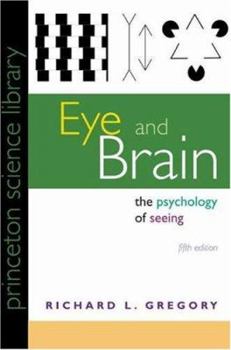Eye and Brain: The Psychology of Seeing - Fifth Edition
Select Format
Select Condition 
Book Overview
Since the publication of the first edition in 1966, Eye and Brain has established itself worldwide as an essential introduction to the basic phenomena of visual perception. Richard Gregory offers clear explanations of how we see brightness, movement, color, and objects, and he explores the phenomena of visual illusions to establish principles about how perception normally works and why it sometimes fails. Illusion continues to be a major theme in...
Format:Paperback
Language:English
ISBN:0691048371
ISBN13:9780691048376
Release Date:December 1997
Publisher:Princeton University Press
Length:296 Pages
Weight:1.01 lbs.
Dimensions:0.7" x 5.0" x 8.0"
Related Subjects
Anatomy Anatomy & Physiology Basic Sciences Behavioral Sciences Biological Sciences Biology Biology & Life Sciences Cognitive Health, Fitness & Dieting Health, Fitness & Dieting Internal Medicine Logic & Brain Teasers Medical Medical Books Medicine Mental Health Neuropsychology Neuroscience Optics Physics Psychology Psychology & Counseling Puzzles & Games Science Science & Math Science & Scientists Science & TechnologyCustomer Reviews
4 ratings
review
Published by Thriftbooks.com User , 16 years ago
good condition book, good price and good shipping. i ordered the book for my class so I cannot really review on the book.
Classic work on perception, updated
Published by Thriftbooks.com User , 21 years ago
This is the classic introduction to perception and psychophysics, and remains as readable and entertaining as it was 30 years ago when I read the first edition. Gregory's was one of the few books on the subject accessible to the non-specialist that tackled some of the more difficult topics, such as how the physiology and anatomy of the eye contributes to perception, as in the case of physiological optics, retinal receptive field geometry, ocular domimance and saccadic eye movements, as well as other traditional areas such as color perception, space perception, and so on. There are also very engrossing discussions of split-brain experiments and optical illusions, probably the most fun part of the book for most people, which are worth reading just for themselves. Overall this is still a great book and one that everyone should read to gain better understanding of how their own visual systems and brains work to enable us to see and perceive the many simple and complex aspects of the visual world. After reading this book you'll have much of the background to read David Marr's later book, entitled simply Vision. This important work contains discussions of more complex visual cortical brain mechanisms and of Marr's important work in that area. Marr discusses his important concept of the "primal sketch" for extracting line primitives, which relates to retinal receptive-field geometry, and then works up from there to more sophisticated spatial-frequency filtering algorithms and mechanisms--ideas that revolutionized our understanding of vision and the brain.
coffee time book
Published by Thriftbooks.com User , 21 years ago
eye and brain!!best reard in coffee time...
A great introduction to the psychology of perception
Published by Thriftbooks.com User , 24 years ago
Who would have thought that a book about the mechanics, physiology and psychology of seeing could be such a riveting read? This is one of the best popular science books around, and I don't even think Gregory intended it to be a layman's book--it's just so well written and interesting that it will delight lay readers as well as its intended student audience.Gregory starts with a short chapter intended to outline some of the less-obvious issues in understanding how we see. Here, as well as throughout the book, he uses optical illusions to make points. The next chapters cover light itself, and the structure and function of the eye and brain, including accounts of how the eye evolved. The rest of the book discusses brightness, colour, and questions such as "How do we visually determine size?" and "Can machines be taught to see?"The book is full of accounts of intriguing experiments and case-studies. Two examples of many: Gregory and a colleague, Jean Wallace, worked in 1961-1962 with a man of 52 whose sight was restored to him after a life of blindness. The account of his slow and incomplete adaptation to the world of sight, and his ultimate slide into depression and death (he had been active and capable as a blind person) is fascinating and moving. Another example: Gregory discusses various researchers who spent some time wearing vision apparatus that dramatically changed their perceptions, such as Stratton, Ewert and the Paterson's. In these cases--where for example the wearer could see their own body suspended in front of them, or see everything upside down--the details of the adaptations of perception are thought-provoking and still not completely understood.Strongly recommended.





